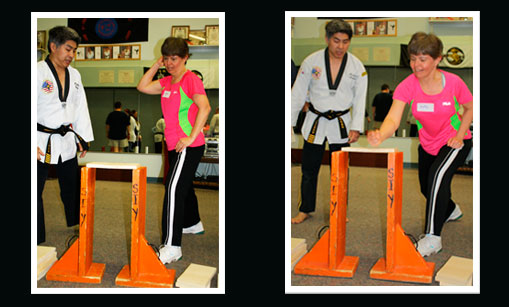INSERTS IN PRINT EDITION
• American Profile
• IGA Market
• ADT Home Security
Visit our advertiser's website by
clicking on their ad!

May 27, 2014 • Headlines
 |
||
|
|
||
|
|
Lady Raider Emily Cumberworth takes her at bat with father Jeff watching from behind the fence. GARY FRANKLIN PHOTO |
|
|
|
||
 |
||
|
|
||
|
|
JCD Eagle senior Trey Brown (8) defends his final home-hosted JCDHS game against the visiting Rising Sun Shiners. GARY FRANKLIN PHOTO |
|
|
|
||
|
|
 |
||
|
|
|||
|
|
Raiders Head Coach Kyle Jolly, SR catcher Sarah Boyken, game-hit winner Carah Beck (1), and Lady Raider pitcher Allie Sexton (10) gather for the beginning of a team victory celebration. GARY FRANKLIN PHOTO |
|
|
|
|
|||
Message to women
Fight back! Decide to hurt someone
Sandy Day Howard
CONTRIBUTING WRITER
“You have to decide today: Are you gonna fight back?” That was the question posed to women on Saturday morning by Indiana State Police Detective Tammy Watson as she spoke about the likelihood of a woman being physically attacked.
Approximately 30 females attended the annual Women’s Self Defense Class sponsored by the Southeastern Indiana YMCA in Batesville on Saturday, May 3. The class is offered annually, free of charge, and is instructed by Master George Dwenger and members of SIY Martial Arts, and by Detective Watson. The women were all ages ranging from young teens to 60 year olds and came from the surrounding area.

SANDY DAY HOWARD PHOTOS
Master George Dwenger shows a participant martial arts. She does break the board.
Participants learned that in the United States, someone is sexually assaulted every two minutes. This averages out to one in every six women who will have to choose in a split second whether or not to defend themselves in the event of an attack.
“Don’t be afraid to hurt someone,” warned Watson. “They’ve made the decision when they created the confrontation that they are going to hurt you. You have to decide at that moment that you are willing to hurt them. You need to be the worst thing this guy ever laid his hands on. Keep in mind you might get hurt. But, don’t let this guy take you down.”
Watson told students when they choose to fight, they need to be prepared to fight with all they’ve got. “Don’t stop until you get away! Scream and yell at the top of your lungs, regardless of what your attacker may be saying. No predator wants a noisy victim,” emphasized the detective.
Dwenger and Watson were assisted by Black Belts Kristen Hobbs, Bryan Priebe, Brandon Schutte, and several of Dwenger’s Tai Kwan Do students as they demonstrated and instructed the group on personal safety. During the class, women learned the parts of their bodies they can use as a weapon and ways to get away from an attacker. During the two and a half hour event, students in the class learned specific self-defense methods that can do physical harm to a potential attacker. They were told to use elbows, fingernails, fists, feet, and knees to injure areas on a man’s body that inflict the greatest amount of pain. They were also taught methods of escape should they be restrained.
“Fight with all you’ve got,” said Watson. “Once he has you restrained or in his car or home, your chances for surviving the assault are greatly diminished. Make up your mind to survive, whatever that takes.”
Kristen Hobbs talked to the group about the ‘concealed weapons’ women carry with them without even knowing it. “Your purse itself is a weapon, if you make it one,” she said as she swung her purse in the air. “The average female carries more weapons in her purse than the US military!”
Hobbs demonstrated the use of keys, ink pens, the corner of an eye shadow or cell phone and other common items many women carry that can be used to fend off an attacker. Hobbs suggested women carry a soup can in their purse and even demonstrated how to use it as a weapon.
Hobbs explained how keeping a can of wasp spray close by can help ward off an invader in the home. The common insecticide, which can be lethal, will do immense harm to an invader and can spray 22 feet into the eyes and face of a potential attacker giving the victim time to get away.
Instructors worked with the women in small groups to demonstrate self-defense techniques that could be vital to their surviving an attack should they become a victim. Women were taught how to move from under an attacker, even if his full body weight was on them. They were instructed how to fight a predator who came at them from behind, what to do if an assailant tried to throw them into a car trunk, and how to fight back if they were attacked in their home.
“Trust your instincts. Be aware of your surroundings at all times, even in familiar places where you are usually comfortable,” warned Dwenger. “Be alert when you’re leaving a building alone, entering a parking lot or garage, or walking down the street. If something doesn’t feel right, go back. If you think you’re being followed, walk fast toward a place where there are people or just stop and yell! A predator will think twice if you seem confident and observant. Make anyone who intends to harm you sorry he picked you to target.”
Women’s safety is also the concern of a new group being formed in Aurora. Konnie Couch and Robin Willoughby are co-founders of an up-and-coming organization encouraging women to be proactive in their own protection by carrying guns. WAR, or ‘Women Armed and Ready,' wants to educate Southeastern Indiana’s women to take control of their safety and the safety of their families. Their motto is “Because a cop won’t fit in your purse,” and they are urging women to arm themselves with handguns. Couch says the effort has the backing of local police and sheriff’s departments in their community. They are currently welcoming ideas on how WAR can benefit women in defending themselves and, once formed, will offer firearm training and other self defense instruction. More information on the association can be seen on Facebook and plans are underway for WAR to be a visible entity in Southeastern Indiana in coming months. For those who don’t want to carry a weapon, Master George Dwenger can be reached through the SEI YMCA in Batesville to learn martial arts as a way of self defense.
More women getting gun permits
More Hoosier women are getting gun permits, mirroring a national trend.
According to a Gallup Poll in 2012, 23 percent of gun owners were women, up from 13 percent in 2005. A front page article in the Indianapolis Star in April, when the National Rifle Association national convention was in town, showed a 42 percent increase in gun permits for Indiana women since 2012; that’s up from 86,617 permits to 123,536. For men, it rose 14 percent. Also, 25 percent of the attendees at the NRA convention were female. The number of gun permits in Indiana increased by 89,000 between 2012 and 2013, according to state police data. There are over 537,900 Hoosiers with a permit.
According to the Ripley County Sheriff’s Office annual statistics reported earlier this year, there were 328 firearm permits applied for or renewed through the sheriff’s office in 2013. That’s an increase of 118 from 2012. In 2011 there were 215 permits. For 2013, the total number of licenses in Ripley County was at 2,712, and of those, 549 (about 20 percent) were for females, 2,163 for males. In surrounding counties, Franklin County has 1,899, Decatur 2,412 and Dearborn, 3,723. State and local fees range from $10 for hunting and target practice to $75 for state lifetime personal protection license. There is no permit required to possess a firearm in your residence or a long gun for hunting or target practice in your vehicle. The permit is only if you want to carry a handgun on your person in public areas.
Old Glory: All about our Stars and Stripes

“I pledge allegiance to the flag of the United States of America, and to the republic for which it stands, one nation under God, indivisible, with liberty and justice for all.”
I am the American Flag
I have earned the right to be heard. I will speak from the wisdom of life.
Look at my face.
I have known over 40 presidents.
I have traveled far. I have lived long and seen much. I have paid the price for my freedom of speech. I have wrapped my arms around those who have died for me.
I am proud of my country.
Preserve my dignity: you have the freedom to choose.
Old Glory they called me. I am the American Flag, Under God, with Liberty and Justice for all.
-- Author unknown
Sandy Day Howard
CONTRIBUTING WRITER
As Memorial Day just passed, thoughts turned toward United States service men and women who have made the ultimate sacrifice for their country. Our flag, “the Stars and Stripes” is flown as the ultimate salute to those brave citizens who served in all branches of the military. It is a symbol of pride for our nation that has been waving over military installations, federal office buildings and outside the homes of patriotic Americans for more than 200 years. As American citizens, we should take great care with the Stars and Stripes to ensure its rich history is respected.
As most Americans are taught, there are 13 stripes on the American flag; seven red and six white. There are 50 stars on the flag, each representing one of the 50 states of the union. The red on the flag represents hardiness and valor, white represents purity and innocence, and the blue symbolizes vigilance, preservation, and justice.
According to The Flag Code of the United States, there are formal and unified ways in which we are to care for and show respect to our country’s banner. There are only two ways the flag can be displayed. It should be either laid flat or be allowed to hang freely. The code also stipulates the proper way for citizens or military personnel to address the US Flag. When our flag passes in a parade, citizens are to come to attention, while those in uniform give the appropriate formal salute. Citizens not in uniform salute by placing their right hand over their heart and men with head cover should remove it and hold it to the left shoulder, hand over heart. On occasions when the national anthem is being played, the code specifies that citizens should stand at attention, facing the flag, and salute or put their hand over their heart.
When “Old Glory” is being displayed indoors, it is to be accorded a place of honor in the room, and should be placed to its own right. In a sanctuary or staging area, it is to be placed to the right of the podium. On occasions when a group of flags are displayed, the US flag is to be placed in the center and at the highest point. When displayed outside at night, it must be illuminated at all times. Interestingly, most have no idea that there is historic significance to the ball at the top of a flagpole. To those who know their flag trivia, this is called the ‘truck.' The truck represents the shot that was heard around the world, fired April 17, 1775, at Lexington, Massachusetts. That ear piercing shot started the Revolutionary War.
The United States flag plays a traditional role in military funerals and occasionally in funerals of other civil servants such as law enforcement officers, firefighters, U.S. Government officials, etc. A burial flag is draped over the deceased’s casket during services. Just prior to the casket being lowered into the ground, the flag is folded and presented to the deceased’s next of kin as a token of respect.
Proper folding of flag
Watching a flag properly folded by members of the military is ceremonious. The methodical turning and tucking of the Stars and Stripes has a specific purpose: to fold our country’s banner into a triangular shape, reminiscent of the ‘cocked hat.' Members of the military form two lines holding the flag waist high. The lower striped section is then folded over the blue field. The folded edge is then folded over to meet the open edge. A triangular fold is then started by bringing the striped corner of the folded edge to the open edge. The outer point is then turned inward parallel with the open edge to form a second triangle. The triangular folding is continued until the entire length of the flag is folded in this manner. When the flag is completely folded, only the blue field should be visible and it should be folded in the triangular shape of a cocked hat. According to the Flag Code, this is the only acceptable fold for a U.S. flag
In times of mourning, the flag is placed at half staff. There is a proper way this must be done. The flag must be hoisted to its peak for an instant, and then lowered to a position halfway between the top and bottom of the staff. The flag is to be raised again to the peak before it is lowered.
On Memorial Day, the flag is to be displayed at half staff until noon and at full staff from noon to sunset. The flag should be flown at half staff for designated government leaders and upon presidential or gubernatorial order. When a U.S. President or former President dies, the flag is to fly at half mast for 30 days. When a flag is worn out, there is a proper way of disposal according to the Flag Code. The section with the stars is cut out, and then both parts are burned together. Tattered flags can be taken to American Legion Posts for proper disposal.
Fight back! Decide to hurt someone
Sandy Day Howard
CONTRIBUTING WRITER
“You have to decide today: Are you gonna fight back?” That was the question posed to women on Saturday morning by Indiana State Police Detective Tammy Watson as she spoke about the likelihood of a woman being physically attacked.
Approximately 30 females attended the annual Women’s Self Defense Class sponsored by the Southeastern Indiana YMCA in Batesville on Saturday, May 3. The class is offered annually, free of charge, and is instructed by Master George Dwenger and members of SIY Martial Arts, and by Detective Watson. The women were all ages ranging from young teens to 60 year olds and came from the surrounding area.

SANDY DAY HOWARD PHOTOS
Master George Dwenger shows a participant martial arts. She does break the board.
Participants learned that in the United States, someone is sexually assaulted every two minutes. This averages out to one in every six women who will have to choose in a split second whether or not to defend themselves in the event of an attack.
“Don’t be afraid to hurt someone,” warned Watson. “They’ve made the decision when they created the confrontation that they are going to hurt you. You have to decide at that moment that you are willing to hurt them. You need to be the worst thing this guy ever laid his hands on. Keep in mind you might get hurt. But, don’t let this guy take you down.”
Watson told students when they choose to fight, they need to be prepared to fight with all they’ve got. “Don’t stop until you get away! Scream and yell at the top of your lungs, regardless of what your attacker may be saying. No predator wants a noisy victim,” emphasized the detective.
Dwenger and Watson were assisted by Black Belts Kristen Hobbs, Bryan Priebe, Brandon Schutte, and several of Dwenger’s Tai Kwan Do students as they demonstrated and instructed the group on personal safety. During the class, women learned the parts of their bodies they can use as a weapon and ways to get away from an attacker. During the two and a half hour event, students in the class learned specific self-defense methods that can do physical harm to a potential attacker. They were told to use elbows, fingernails, fists, feet, and knees to injure areas on a man’s body that inflict the greatest amount of pain. They were also taught methods of escape should they be restrained.
“Fight with all you’ve got,” said Watson. “Once he has you restrained or in his car or home, your chances for surviving the assault are greatly diminished. Make up your mind to survive, whatever that takes.”
Kristen Hobbs talked to the group about the ‘concealed weapons’ women carry with them without even knowing it. “Your purse itself is a weapon, if you make it one,” she said as she swung her purse in the air. “The average female carries more weapons in her purse than the US military!”
Hobbs demonstrated the use of keys, ink pens, the corner of an eye shadow or cell phone and other common items many women carry that can be used to fend off an attacker. Hobbs suggested women carry a soup can in their purse and even demonstrated how to use it as a weapon.
Hobbs explained how keeping a can of wasp spray close by can help ward off an invader in the home. The common insecticide, which can be lethal, will do immense harm to an invader and can spray 22 feet into the eyes and face of a potential attacker giving the victim time to get away.
Instructors worked with the women in small groups to demonstrate self-defense techniques that could be vital to their surviving an attack should they become a victim. Women were taught how to move from under an attacker, even if his full body weight was on them. They were instructed how to fight a predator who came at them from behind, what to do if an assailant tried to throw them into a car trunk, and how to fight back if they were attacked in their home.
“Trust your instincts. Be aware of your surroundings at all times, even in familiar places where you are usually comfortable,” warned Dwenger. “Be alert when you’re leaving a building alone, entering a parking lot or garage, or walking down the street. If something doesn’t feel right, go back. If you think you’re being followed, walk fast toward a place where there are people or just stop and yell! A predator will think twice if you seem confident and observant. Make anyone who intends to harm you sorry he picked you to target.”
Women’s safety is also the concern of a new group being formed in Aurora. Konnie Couch and Robin Willoughby are co-founders of an up-and-coming organization encouraging women to be proactive in their own protection by carrying guns. WAR, or ‘Women Armed and Ready,' wants to educate Southeastern Indiana’s women to take control of their safety and the safety of their families. Their motto is “Because a cop won’t fit in your purse,” and they are urging women to arm themselves with handguns. Couch says the effort has the backing of local police and sheriff’s departments in their community. They are currently welcoming ideas on how WAR can benefit women in defending themselves and, once formed, will offer firearm training and other self defense instruction. More information on the association can be seen on Facebook and plans are underway for WAR to be a visible entity in Southeastern Indiana in coming months. For those who don’t want to carry a weapon, Master George Dwenger can be reached through the SEI YMCA in Batesville to learn martial arts as a way of self defense.
More women getting gun permits
More Hoosier women are getting gun permits, mirroring a national trend.
According to a Gallup Poll in 2012, 23 percent of gun owners were women, up from 13 percent in 2005. A front page article in the Indianapolis Star in April, when the National Rifle Association national convention was in town, showed a 42 percent increase in gun permits for Indiana women since 2012; that’s up from 86,617 permits to 123,536. For men, it rose 14 percent. Also, 25 percent of the attendees at the NRA convention were female. The number of gun permits in Indiana increased by 89,000 between 2012 and 2013, according to state police data. There are over 537,900 Hoosiers with a permit.
According to the Ripley County Sheriff’s Office annual statistics reported earlier this year, there were 328 firearm permits applied for or renewed through the sheriff’s office in 2013. That’s an increase of 118 from 2012. In 2011 there were 215 permits. For 2013, the total number of licenses in Ripley County was at 2,712, and of those, 549 (about 20 percent) were for females, 2,163 for males. In surrounding counties, Franklin County has 1,899, Decatur 2,412 and Dearborn, 3,723. State and local fees range from $10 for hunting and target practice to $75 for state lifetime personal protection license. There is no permit required to possess a firearm in your residence or a long gun for hunting or target practice in your vehicle. The permit is only if you want to carry a handgun on your person in public areas.
Old Glory: All about our Stars and Stripes

“I pledge allegiance to the flag of the United States of America, and to the republic for which it stands, one nation under God, indivisible, with liberty and justice for all.”
I am the American Flag
I have earned the right to be heard. I will speak from the wisdom of life.
Look at my face.
I have known over 40 presidents.
I have traveled far. I have lived long and seen much. I have paid the price for my freedom of speech. I have wrapped my arms around those who have died for me.
I am proud of my country.
Preserve my dignity: you have the freedom to choose.
Old Glory they called me. I am the American Flag, Under God, with Liberty and Justice for all.
-- Author unknown
Sandy Day Howard
CONTRIBUTING WRITER
As Memorial Day just passed, thoughts turned toward United States service men and women who have made the ultimate sacrifice for their country. Our flag, “the Stars and Stripes” is flown as the ultimate salute to those brave citizens who served in all branches of the military. It is a symbol of pride for our nation that has been waving over military installations, federal office buildings and outside the homes of patriotic Americans for more than 200 years. As American citizens, we should take great care with the Stars and Stripes to ensure its rich history is respected.
As most Americans are taught, there are 13 stripes on the American flag; seven red and six white. There are 50 stars on the flag, each representing one of the 50 states of the union. The red on the flag represents hardiness and valor, white represents purity and innocence, and the blue symbolizes vigilance, preservation, and justice.
According to The Flag Code of the United States, there are formal and unified ways in which we are to care for and show respect to our country’s banner. There are only two ways the flag can be displayed. It should be either laid flat or be allowed to hang freely. The code also stipulates the proper way for citizens or military personnel to address the US Flag. When our flag passes in a parade, citizens are to come to attention, while those in uniform give the appropriate formal salute. Citizens not in uniform salute by placing their right hand over their heart and men with head cover should remove it and hold it to the left shoulder, hand over heart. On occasions when the national anthem is being played, the code specifies that citizens should stand at attention, facing the flag, and salute or put their hand over their heart.
When “Old Glory” is being displayed indoors, it is to be accorded a place of honor in the room, and should be placed to its own right. In a sanctuary or staging area, it is to be placed to the right of the podium. On occasions when a group of flags are displayed, the US flag is to be placed in the center and at the highest point. When displayed outside at night, it must be illuminated at all times. Interestingly, most have no idea that there is historic significance to the ball at the top of a flagpole. To those who know their flag trivia, this is called the ‘truck.' The truck represents the shot that was heard around the world, fired April 17, 1775, at Lexington, Massachusetts. That ear piercing shot started the Revolutionary War.
The United States flag plays a traditional role in military funerals and occasionally in funerals of other civil servants such as law enforcement officers, firefighters, U.S. Government officials, etc. A burial flag is draped over the deceased’s casket during services. Just prior to the casket being lowered into the ground, the flag is folded and presented to the deceased’s next of kin as a token of respect.
Proper folding of flag
Watching a flag properly folded by members of the military is ceremonious. The methodical turning and tucking of the Stars and Stripes has a specific purpose: to fold our country’s banner into a triangular shape, reminiscent of the ‘cocked hat.' Members of the military form two lines holding the flag waist high. The lower striped section is then folded over the blue field. The folded edge is then folded over to meet the open edge. A triangular fold is then started by bringing the striped corner of the folded edge to the open edge. The outer point is then turned inward parallel with the open edge to form a second triangle. The triangular folding is continued until the entire length of the flag is folded in this manner. When the flag is completely folded, only the blue field should be visible and it should be folded in the triangular shape of a cocked hat. According to the Flag Code, this is the only acceptable fold for a U.S. flag
In times of mourning, the flag is placed at half staff. There is a proper way this must be done. The flag must be hoisted to its peak for an instant, and then lowered to a position halfway between the top and bottom of the staff. The flag is to be raised again to the peak before it is lowered.
On Memorial Day, the flag is to be displayed at half staff until noon and at full staff from noon to sunset. The flag should be flown at half staff for designated government leaders and upon presidential or gubernatorial order. When a U.S. President or former President dies, the flag is to fly at half mast for 30 days. When a flag is worn out, there is a proper way of disposal according to the Flag Code. The section with the stars is cut out, and then both parts are burned together. Tattered flags can be taken to American Legion Posts for proper disposal.
 |
 |
|














